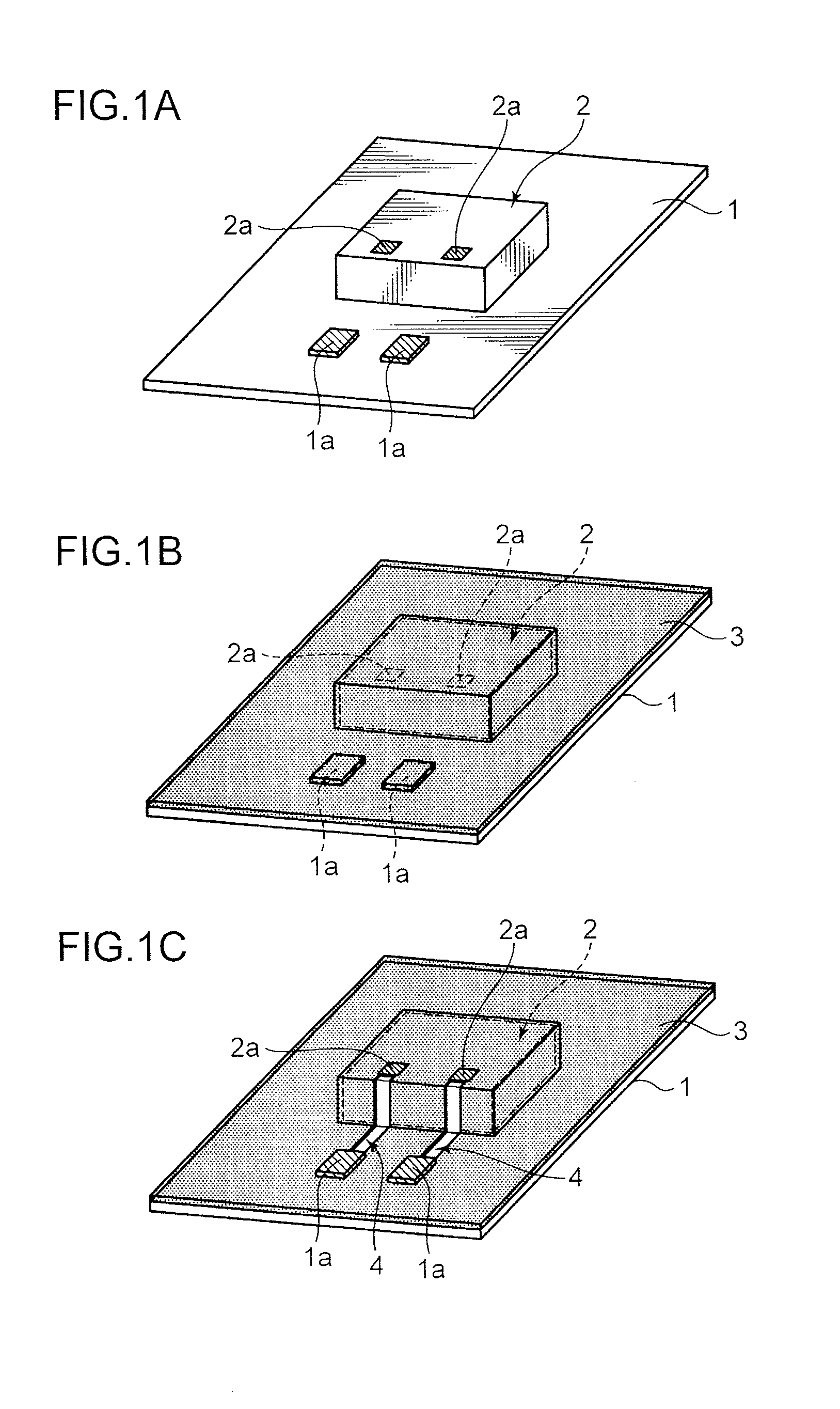Three-dimensional structure for wiring formation
- Summary
- Abstract
- Description
- Claims
- Application Information
AI Technical Summary
Benefits of technology
Problems solved by technology
Method used
Image
Examples
first embodiment
[0039]The preferred embodiments of the method of mounting a semiconductor chip according to the present invention are now explained with reference to the drawings.
[0040]FIG. 1 and FIG. 2 are schematic diagrams explaining the respective processes in the method of mounting a semiconductor chip of this embodiment. Note that, in FIG. 1 and FIG. 2, 1 represents an insulating base material, 1a represents an electrode pad, 2 represents a semiconductor chip, 2a represents a bonding pad, 3 represents a resin coating, 4 represents a wiring gutter, 5 represents a plating catalyst, 6 represents an electroless plating coating, and 7 represents a wiring.
[0041]In the production method of this embodiment, as shown in FIG. 1A, foremost, an insulating base material 1 mounted with a semiconductor chip 2 in a predetermined chip mounting area is prepared.
[0042]Note that the semiconductor chip 2 is fixed to the predetermined chip mounting area on the surface of the insulating base material 1 using an adh...
second embodiment
[0101]A preferred method of connecting a plurality of semiconductor chips according to the present invention is now explained with reference to the drawings. Note that, since the respective processes are the same as the processes explained in the first embodiment, the detailed explanation of redundant portions is omitted. Moreover, since the components given the same reference numerals as the reference numerals of the first embodiment are the same components, the explanation thereof is omitted.
[0102]FIG. 4 and FIG. 5 are schematic diagrams explaining the respective processes in the method of connecting a plurality of semiconductor chips of this embodiment. In FIG. 4 and FIG. 5, 1 represents an insulating base material, 2 represents a first semiconductor chip, 12 represents a second semiconductor chip, 2a, 12a represent bonding pads, 3 represents a resin coating, 4 represents a wiring gutter, 5 represents a plating catalyst, and 6 represents an electroless plating coating.
[0103]In th...
embodiment
Third (2) Embodiment
[0147]Another embodiment of the three-dimensional structure 200 is a three-dimensional structure that has a concave-convex form including a gutter for wiring having at least partially a width of 20 μm or less, wherein at least a part of a wiring conductor is embedded in the gutter for wiring, and a wiring that extends in such a manner as to creep along the concave-convex form is provided.
[0148]FIGS. 23 and 24 are schematic diagrams explaining the three-dimensional structure 200 of the present embodiment. Note that, in FIGS. 23 and 24, reference numeral 901 represents an insulating base material, 901a an electrode pad, 902 a semiconductor chip, 902a a pad part, 905 a gutter for wiring, and 907 a wiring (wiring conductor).
[0149]As illustrated in FIG. 23, in the three-dimensional structure of the present embodiment the gutter for wiring 905 is provided on the surface of the insulating base material 901 and the surface of the semiconductor chip 902. Thus, the surface...
PUM
 Login to View More
Login to View More Abstract
Description
Claims
Application Information
 Login to View More
Login to View More - R&D
- Intellectual Property
- Life Sciences
- Materials
- Tech Scout
- Unparalleled Data Quality
- Higher Quality Content
- 60% Fewer Hallucinations
Browse by: Latest US Patents, China's latest patents, Technical Efficacy Thesaurus, Application Domain, Technology Topic, Popular Technical Reports.
© 2025 PatSnap. All rights reserved.Legal|Privacy policy|Modern Slavery Act Transparency Statement|Sitemap|About US| Contact US: help@patsnap.com



